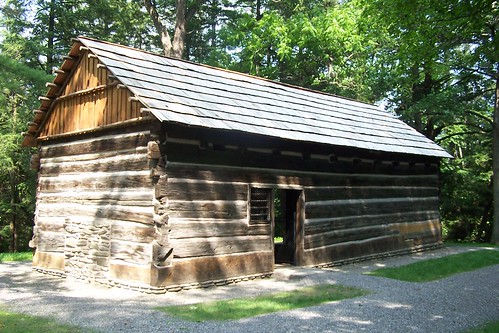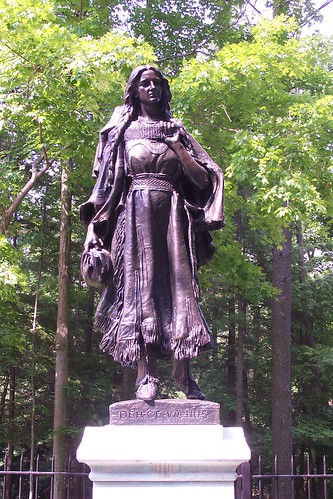She was a slender slip of a girl to send alone at nightfall a mile or more to borrow the horse that she was to lead home before breakfast in the early morning; a fair-skinned. blue-eyed girl of thirteen, delicate
in feature. little hands and feet, the daughter of the well-to-do farmer, Thomas Jemison, a Scotch-Irish settler on the frontier of Pennsylvania. There were six of the Jemison boys and girls. and a very happy home was theirs, with their good and thrifty mother.
They heard of trouble with the Indians in other localities along the border, but they felt safe in their frontier home, even when they heard the wolves howl at night, or missed a lamb or a calf after the visit of a prowling panther. Mr. Jemison must have been over-driven with work that Spring day, when Mary was sent alone to borrow the horse. No doubt the adventure was a pleasant change for the child, although she used to tell, in her after life, that she had a warning that night that something was going to happen.
She was safe home betimes in the morning, leading her horse, and hungry for the breakfast she knew would be waiting for her. She found that company had arrived the night before, a woman and three little children, and the woman's brother-in-law, the family of a man that was "fighting in Washington's army." Mary's mother was getting breakfast. The children were playing together, The two elder Jemison boys were at work near the barn. The men were outside, There was the sound of the firing of guns, shot after shot, in quick succession. and before those women and children could speak for fright, in rushed the savages that had killed the uncle of the children, and had bound Mr. Jemison at his very door. In a few moments, they were all helpless prisoners, their hands tied behind them, and the Indians driving them into the woods, lashing the little children forward with a whip.
Each Indian carried away as much plunder as he could, the bread, meal, and meat of Mrs. Jemison's larder, and the breakfast her children might not taste. All day they marched to the westward, never a mouthful of food or a drop of water, expecting every moment to be tomahawked or burnt at the stake. At night. they were suffered to drop down on the damp ground, without fire or shelter, the pitiful wailing of the starving children awakening no pity in the savage heart. On again they moved at early daybreak, halting at sunrise, when Mrs. Jemison's meat and bread were sparingly given out.
At the end of the second day's journey, the good mother, who had cheered her dear ones all she could, saw the Indians taking off Mary's shoes and stockings and putting a pair of moccasins on her feet. The same was done to the little boy whose father was in Washington's army. The mothers knew what that meant. The two children were to be adopted by the Indians. All but Mary and the little boy would never see another sunset.
Mrs. Jemison managed to say a last word to her little Mary. She bade her good-bye, charging her to remember her prayers and the English language. and not to try running away from the Indians. "I was crying," said Mary Jemison, in telling the story years after, "and an Indian Came and led me away. 'Don't cry, Mary,' mother called after me. 'God bless you. my child.'"
She and the little boy lay under the bushes that night with an Indian guarding them. They never slept, but the Indian did; and then the boy begged Mary to run away with him, to hide in the woods; but her mother's counsel kept her where she was.
The next morning they were hurried forward again, she and the boy the only captives. They knew, without being told, that the others of their party, father, mother, brothers, and sisters, had been murdered in the night, and that they would never see them again. They dared not cry, dared not complain.
The next night, they encamped by a fire. It had been raining, and they were cold and wet. Again Mary ate her mother's bread, and, crouching by the fire, she watched the Indians dress the bloody scalps they had brought with them. One was combing the gory locks Of her mother; another, the flaxen hair of her little brothers and sisters. If she fell asleep at all, it was to start and see those horrible scalps drying before the fire.
Through rain and snow, they marched on, day after day, at last reaching Fort Pitt, now Pittsburg. There the face and hair of the captives were painted red. A young white man, a prisoner, had been added to their company. They were shut up alone in an empty building inside the fort. Another terrible night was passed : for they might well dread the morrow, when, they had reason to believe, they would be horribly tortured and put to death, or turned into the forest to save themselves from the wild beasts as best they could. Early in the morning, the young man and the little boy were taken out of the fort, leaving Mary alone in her terror. She never heard from them again ; never knew their fate.
Now, two Seneca squaws, who had lost a brother in the warfare going on between red man and white man, were looking at that moment for a prisoner, or an enemy's scalp. Either would comfort them for the loss of their brother. It was a custom among the Indians for the mourners of the dead in battle to welcome the returning braves and claim a prisoner or a scalp. With the prisoner they could do what they liked, torture or adopt, just as they pleased. The two Seneca squaws received a prisoner and scalps in this case.
They were extremely pleased with Mary, and decided to adopt her. So she sailed away with them in their canoe, a larger canoe going before them down the Ohio, an Indian standing in the stern, holding upon a pole the scalps of her family. Her mother's bright red hair floated before her eyes, and seemed leading her to her new home. They passed a Shawnee town, where she saw a smouldering fire and the suspended fragments of the bodies of white people, who had just been burned to death. About eighty miles by river from Fort Pitt they landed at the wigwam of the Seneca Squaws.
Her new sisters were very kind to her. They named her Deh-ge-wa-nus, meaning Two-falling-voices. The little pale-faced stranger, who had taken their brother's place in their hearts, had lulled by her voice the voice of their sorrow. She was given light work only to do, and was forbidden to speak English. Remembering her mother's last words, she would go away alone and repeat her prayers and familiar English words. In time, she ceased doing so ; but she never wholly forgot her mother's tongue.
The Story of her life for four years at Shenanjee, where in summer she planted, and hoed, and harvested the corn, and squash, and beans, and where in winter she went into the forest with the hunters ; her hopes of escape more than once prevented by the watchful affection of her Indian sisters ; her early marriage to Sin-nin-jee, a Delaware brave--all this. as told in the account of her life by James E. Seaver, is a romance of thrilling incident, giving us a deep insight into Indian life. Singular as it may seem, she became contented, even happy. "Only one thing marred my happiness," she said in after years, "remembering my parents and the home I loved."
Some of Sin-nin-jee's kindred lived in the Genesee valley in Western New York, the fair hunting grounds of the Senecas in the Iroquois long house. In the fall of 1758, when her baby Thomas was about nine months old, she set out with her husband and three of his brothers, and her baby, of course, to visit these relatives in the Genesee. Sin-nin-jee, hearing of good winter hunting "down the river," concluded not to go to the Genesee until the spring. Mary went on with his brothers, her big baby on her back, traveling nearly six hundred miles on foot through an almost pathless wilderness, reaching Little Beard's Town (now Cuylerville) late in the autumn. The fatigue and suffering of that journey she never forgot, and in her old age she would go over the trail in her fancy, "sleeping on the naked ground. with nothing but my wet blanket to cover us."
Little Beard's Town was a place of considerable importance, to the Senecas at least, in 1759. It was on the west bank of the beautiful Genesee river. She found that many of the Seneca braves were off on the war path, helping the French against the English. She saw those of her own race brought in as captives and tortured, but her pleadings for them often saved their lives.
She was the first and only white woman in the country. Not until 1797, thirty-eight years after, was any of the land around her sold to the whites. The first orchard west of the Genesee, planted by a white settler, was in 1799, when Mary Jemison had cultivated her Indian patch for forty-one years. At the time of the treaty of Stanwix, in 1784, she had been with the Indians twenty-nine years. Seventy-two years she lived in the valley of the Genesee, and then left it, rather than be separated from her adopted people.
But we anticipate. The summer after her arrival at Little Beard's Town. she heard of the death of Sin-nin-jee, in the Ohio country. Not long after, she became the wife of the big chief Hickatoo. a famous warrior of seventeen campaigns, whose prowess in taking Cherokee scalps was only equaled by his wrestling and fleetness of foot. By him she had many children, her half-Indian boys giving her no end of trouble with their quarreling, One of them, John, brutally killed two of his brothers, Thomas and Jesse. before he was finally killed himself in a drunken dispute. But the things that were horrible to her, alien to her nature, she had to submit to, as Deh-ge-wa-nus, the mother of Seneca braves.
Mary Jemison's house, during the Revolutionary war, was headquarters for Brant and the Butlers. "Many a night," she said, "have I pounded samp for them from sunset to sunrise, and furnished them with provisions for their journey, and clean clothing." But she became attached to the life she lived. She fled with the women and children of the Senecas before Sullivan's raid in 1779, showing the same unwillingness to be restored to her race that she had shown several years before. when the King of England offered a bounty for returned prisoners. On that occasion. she had hidden, fearing that she would be taken back by some one anxious to claim the reward.
After the close of the Revolutionary war, however, when her Indian brother Black Coals offered her her liberty, and her son Thomas wanted her to seek her relatives and let him be her guide in finding them, she was inclined to go. But when she learned that Thomas would not be permitted to go with her, that she must leave her favorite son behind her, she resolved to stay with the Indians the rest of her day. "If I should find my relatives, those two brothers that escaped that morning, they might despise my Indian children."
She lived at Gardeau Flats until she followed the Senecas to the Buffalo Creek reservation in 1831. She was never sick, and, although she did not look strong, she did more work in a day the year round than
most men ; that is, white men. "I backed all the boards that were used about my house." she said, "from a mill nearly five miles off, my young children helping me." As late as 1823, when she was eighty-one years old, she husked her corn as ever and carried it into the barn.
When the Senecas sold their lands to Thomas Morris in 1828, the Indians asked that a reservation be made for the white woman, a free gift from them to their captive. Morris thought, from the description of the lands named at Gardeau Flats, that the reservation did not exceed three hundred acres at the most. She described the boundaries of what she wanted, and outwitted the crafty speculator completely. After much delay and vexation (Red Jacket opposing her bitterly), she was declared the rightful owner of more than seventeen thousand acres of land in the garden of the state of New York, the tract including Gardeau flats and the surrounding hills. But for the trickery of white men, who robbed her as they would an Indian, she would have been in her old age one of the wealthiest women in the country. Once she was sadly imposed upon by a man calling himself George Jemison and pretending to be her first cousin. She gave him land and many farms, until he proved himself to be what he was.
When the Genesee country was opened to settlers in 1789, Mary Jemison was by no means disposed to make herself one with them. She kept aloof, and said as little to her gaping visitors as an Indian would have done. They looked upon her as a curiosity, visited her house as they would a museum. She dressed like a squaw, and was an Indian in her religion. When led to talk about her capture, she would shed tears. She spoke English fairly well, and she never lost her soft, white skin nor the pinkish glow of her cheeks. She clung to her moccasins always, and slept on the floor on skins, eating her food from her lap, Indian fashion.
As she grew feeble with age (she lived to be ninety-one), her memory of her childhood came back to her more distinctly. Not long before she left the valley, the agent of a large land owner in the locality tried to prevail upon her to remain at Gardeau Flats, for she was bent upon joining the Senecas at Buffalo Creek reservation. "Her children wanted to go," she said; they would be happier." That was enough for her. The agent was a native of the north of Ireland, and, in his earnest plea, his Scotch-Irish dialect came out. She caught it at once, looked up into his face in a half-startled way, her memory trying to recall something. "Are ye fra that kentry, too?" she asked, smiling. "I know noo whar ye carn from, and I leck ye better nor better." But she did not consent to stay at Gardeau Flats, nor was she ever sought out and found by her kindred, if any she had. She died on the Buffalo Creek reservation in September, 1833, and was buried near the grave of Red Jacket. Her little feet were encased in moccasins, and her burial dress was like the one the Indians gave the captive child one hundred years before.
The good missionary that visited her not long before her death found her in a poor hut, on a low bunk, a little straw on the boards, over which a blanket was spread. She had just awakened from sleep and began telling her dream. "It was that second night after we were taken," she said. "and we were so tired and hungry. My brothers and little sister Betsy were asleep on the ground. Mother put her arm around me and said, 'Be a good girl, Mary. God will take care of you.'" When she heard the missionary saying the Lord's prayer, she started up and smiled. "That is just what mother used to say ; that is what I could
not remember all these years."
In 1874 her remains were removed to the grounds of Hon. William P. Letchworth, of Glen Iris, Portageville, N.Y., and re-buried by her descendants near the old councilhouse of the Senecas, where Mr. Letchworth has his valuable collection of Indian relics. It is believed that it was within the walls of this old council-house that Mary Jemison rested after her long journey from the Ohio country.








